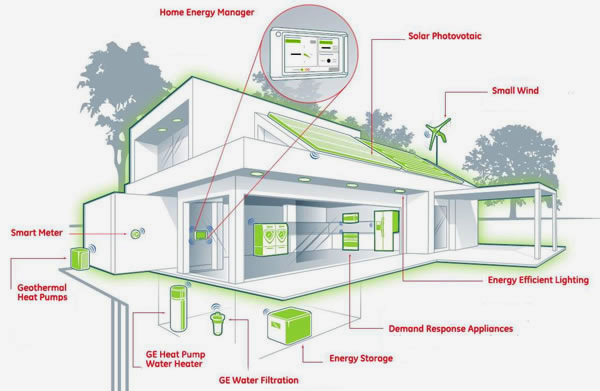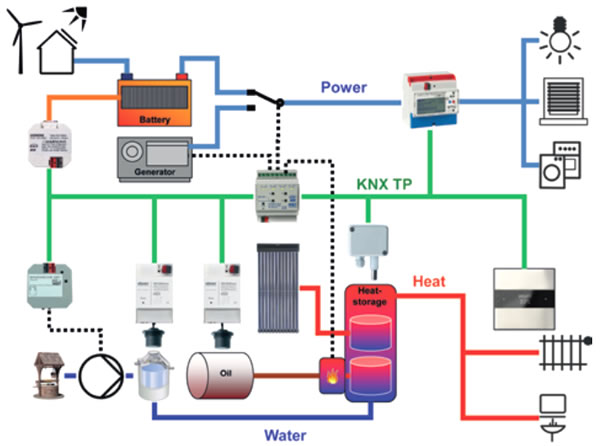 By Paul Foulkes, EchoHouse.
By Paul Foulkes, EchoHouse.
In Part 1 and Part 2 of this series, we looked directly at community energy and how, with KNX, the required infrastructure can be supplied. In this final part, we will go beyond community energy, and look at why KNX can address the need for an integrated infrastructure.
I was at a CIBSE (Chartered Institution of Building Services Engineers) event recently – there was a debate about whether smart cities will require district heating. It was an interesting evening, and at the end, what stuck in my mind was that, whatever the outcome, smart cities need smart buildings. And to bring those buildings together you need a smart infrastructure. This means that whatever heating system you employ in your buildings, it is vital that the people managing them, the people supplying them with energy and the people buying that energy know what is going on at any time in the daily/weekly or maintenance cycle within that building. This allows them to make decisions about the best place to find that energy, and the best place to use it.

Monitoring Down to Room Level
All of these control requirements need an integrated control and monitoring system. These needs are satisfied by using KNX. Having the possibility to monitor down to individual room level, allows energy trending information to be gained from a house, a hotel, student accommodation or a care facility.
With KNX providing the structured integrated backbone, you have access to, and can use in any way you want, a mass of information – not only from the building’s KNX, but from any protocol such as Modbus, for metering. In this case, it permits intelligent billing information to be available and broken down for all involved – identifying exactly when and where energy is used. With residential half-hourly billing tariffs not far away, and the increasing use of household energy storage (e.g. the Tesla Powerwall), knowing when best to use energy, either grid or stored, will be essential to further reduce our overall energy burden.

The KNX Backbone
By having one backbone that creates the link to all the other protocols results in one system controlling information for all users. KNX is capable of running a billing platform, so community energy producers can easily control, monitor and bill for any type of energy or resource such as electricity, gas and water). The information relative to each user can be displayed locally (energy use and billing information in the home), the status of the system structure can be displayed to the facility management (FM) team, or the overall view of the resource to the operator manager.
Of course, all of these facilities are available using other systems, but without a common backbone, they become disparate and control can quickly break down. As well as the obvious physical issue concerning a breakdown, with disparate systems it can often be difficult to isolate which system is responsible and therefore which maintenance contractor to contact. Using remote failure indications, such as email or pop-ups at the FM monitoring post allows specific problems to be dealt with quickly and also identified as to which contractor is responsible. Bringing systems together creates a synergy and this highlights the effectiveness of the KNX infrastructure.
Further than Just the ‘Community’
In the first two articles of this series, the ‘community’ part of the various scenarios could be representative of any localised network. It is this enlarged network that requires an infrastructure, far beyond what a collection of smart gadgets can supply.
Sometimes, localised requirements for applications such as AV, door access and intercoms are better served by non-KNX solutions, but, if building networks become dependent upon a rapidly-evolving and changing Wi-Fi environment such as POE, there is a risk of losing the important need for future-proofing and robustness. These evolving networks, and their important place within the building fabric, is not precluded by the installation of a KNX bus.

Developing New Markets
There are huge market opportunities in creating KNX-supported infrastructure networks based around multiple individual houses. It could follow the same trajectory as KNX BMS in hospitality and MDUs.
Social and affordable housing is at the forefront of this building revolution. Housing associations recognise the need for smarter buildings; their long-term relationship with their buildings gives them a different outlook than the classic large-scale house builders, and they also recognise the possibilities for communities to take control of their energy production and distribution.
Developers, be they commercial, housing authorities, local authorities etc, need to be made aware of the advantages of installing a suitable future-proof, robust, effective and proven infrastructure – and not just filling houses with smart gadgets that may have to be replaced in 24 months.
Conclusion
Eventually, the community, or smart city, infrastructure will include building information that may possibly come from BIM (Building Information Modelling) as well as such things as generated energy availability, even traffic flow and commuter numbers. It is important to realise however, that collecting information is not an objective in itself, but a necessary tool to facilitate energy management at all levels, from house, to building, to grid.
It is this level of information, and the ability for it to be integrated across the network that will enable smart cities, smart communities and smart homes. KNX can play the central role within this network.
Paul Foulkes is an engineer and KNX consultant for EchoHouse, with the ambition of integrating technology and community and making our living environment better. He is also a Business Development Manager for Entech Ltd.












